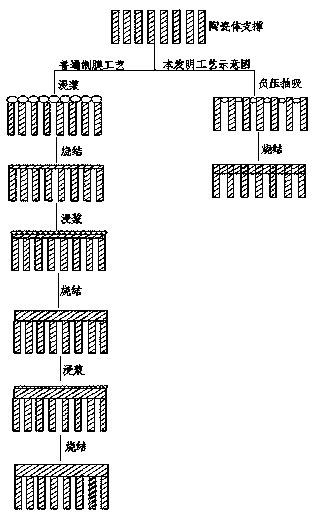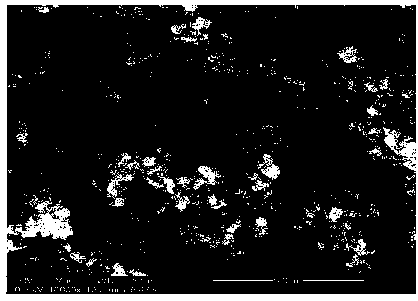A kind of preparation method of ceramic composite membrane
A technology of ceramic composite membranes and porous ceramics, applied in chemical instruments and methods, membrane technology, semi-permeable membrane separation, etc., can solve the problems of high energy consumption, poor membrane layer binding force, long preparation cycle, etc., and achieve low energy consumption , easy to operate, avoid the effect of poor binding force
- Summary
- Abstract
- Description
- Claims
- Application Information
AI Technical Summary
Problems solved by technology
Method used
Image
Examples
preparation example Construction
[0010] Such as figure 1 Shown, the present invention is a kind of preparation method of ceramic composite membrane, and its steps are:
[0011] (1) Select metal particles with a particle size of 1 / 2-2 / 3 of the average surface pore size of the porous ceramic support (such as: Ti, Al and other metals), based on the quality of the solvent or water used, 0.05% by weight -20% is added to organic solvent or water, and based on the quality of solvent or water, 0.1%-5% dispersant and 1%-5% thickener are added in sequence to prepare a uniformly dispersed, Stable suspension of metal particles;
[0012] (2) Immerse the cleaned porous ceramic support in the slurry prepared in step (1), and use negative pressure to absorb the metal particles in the slurry in the pores on the surface of the porous ceramic support; The negative pressure is 0.01-0.1MPa, and the soaking time is 10-300s. After soaking, wash off the excess metal particles attached to the surface;
[0013] (3) Put the support ...
Embodiment 1
[0021] Example 1: Porous α-Al 2 o 3 Sheet-like ceramics are used as supports with a pore size of 3 μm.
[0022] (1) Slurry preparation: using water as the solvent, based on the solvent quality, add 1.9 μm Ti particles, polyethyleneimine, ethyl cellulose and carboxymethyl at 2%, 0.5% and 1% by mass respectively A mixture of ethyl cellulose sodium (1:1wt), in which polyethyleneimine is a dispersant, and a mixture of ethyl cellulose and sodium carboxymethylcellulose (1:1wt) is a thickener;
[0023] (2) Pore filling: Put the cleaned porous ceramic support into the slurry configured in step (1) and draw negative pressure for slurry soaking adsorption. The negative pressure is 0.03Mpa, and the soaking time is 100s. More metal particles will be adsorbed in the pores of the porous ceramic support body, and excess metal particles attached to the surface of the support body will be removed after soaking.
[0024] (3) In-situ oxidation: put the component prepared in step (2) into oxyg...
Embodiment 2
[0025] Example 2: Porous α-Al 2 o 3 Sheet-like ceramics are used as supports with a pore size of 8 μm.
[0026] (1) Slurry preparation: use isopropanol as solvent, based on solvent mass, add 5.3 μm Ti particles, hexadecyl trimethyl quaternary ammonium salt with mass percentage of 10%, 2% and 3% respectively , a mixture of ethyl cellulose and sodium carboxymethyl cellulose (1:1wt), in which hexadecyltrimethyl quaternary ammonium salt is a dispersant, a mixture of ethyl cellulose and carboxymethyl cellulose (1:1wt) as a thickener;
[0027] (2) Pore filling: Put the cleaned porous ceramic support into the slurry configured in step (1) and draw negative pressure for slurry soaking adsorption. The negative pressure is 0.05Mpa, and the soaking time is 100s. More metal particles will be adsorbed in the pores of the porous ceramic support body, and excess metal particles attached to the surface of the support body will be removed after soaking.
[0028] (3) In-situ oxidation: put ...
PUM
| Property | Measurement | Unit |
|---|---|---|
| pore size | aaaaa | aaaaa |
| pore size | aaaaa | aaaaa |
| pore size | aaaaa | aaaaa |
Abstract
Description
Claims
Application Information
 Login to View More
Login to View More - R&D
- Intellectual Property
- Life Sciences
- Materials
- Tech Scout
- Unparalleled Data Quality
- Higher Quality Content
- 60% Fewer Hallucinations
Browse by: Latest US Patents, China's latest patents, Technical Efficacy Thesaurus, Application Domain, Technology Topic, Popular Technical Reports.
© 2025 PatSnap. All rights reserved.Legal|Privacy policy|Modern Slavery Act Transparency Statement|Sitemap|About US| Contact US: help@patsnap.com


